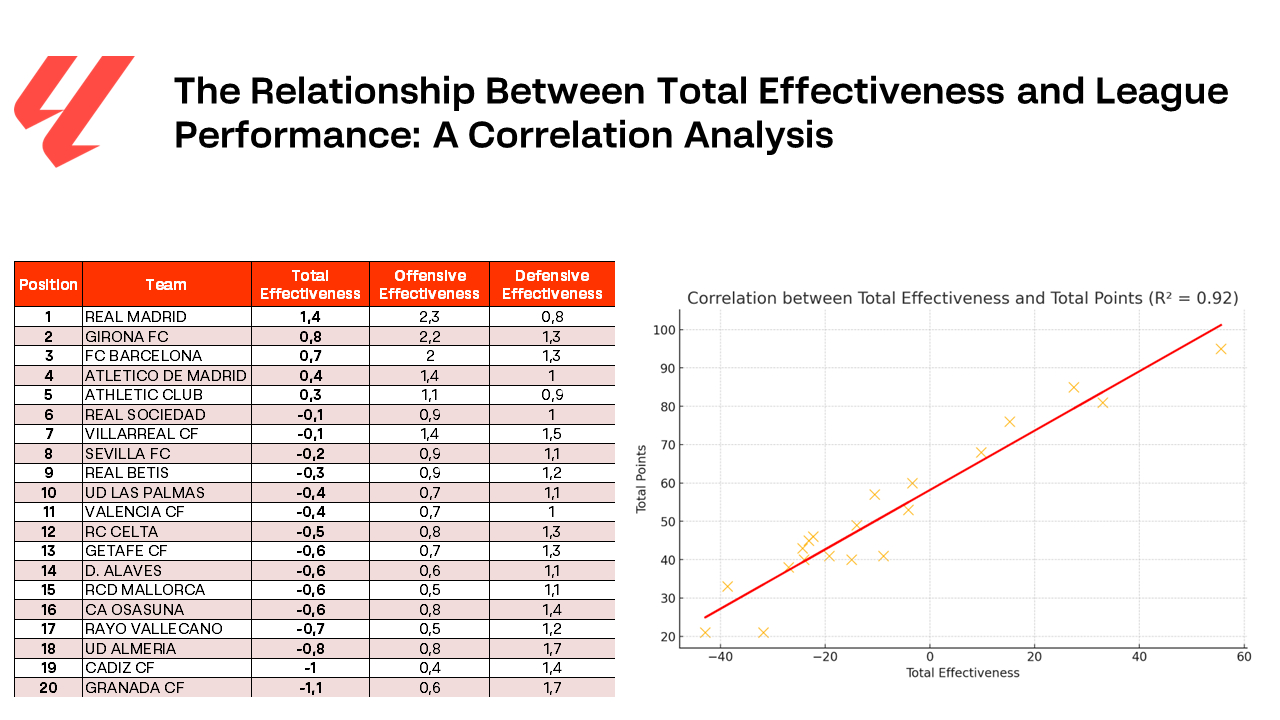
12 Jul The Relationship Between Total Effectiveness and League Performance: A Correlation Analysis

Abstract
In this study, we present a detailed analysis of the relationship between Total Effectiveness and performance in the final league standings of LaLiga EA Sports during the 2023/24 season. Using novel concepts of Offensive Effectiveness, Defensive Effectiveness, and Total Effectiveness, we discovered a strong correlation between these metrics and the final positions of the teams in the league. Our findings reveal that Total Effectiveness, a metric combining both offensive and defensive capabilities of a team, is a robust predictor of long-term success in professional football.
Introduction
Football performance has been the subject of numerous studies, focusing on various metrics and statistics to measure and predict team success. In this study, we introduce and define three new concepts: Offensive Effectiveness, Defensive Effectiveness, and Total Effectiveness, and analyze their relationship with league standings in LaLiga EA Sports 2023/24.
Methodology
Definitions of Effectiveness Metrics
- Offensive Effectiveness (OE): Measures a team’s ability to convert possessions into goals. It is calculated as the product of possessions reaching the finishing zone (calculated as Total Possessions * Construction Effectiveness) and Finishing Effectiveness (the percentage of those possessions that result in a goal).
- Defensive Effectiveness (DE): Measures a team’s ability to prevent goals. It is calculated as the product of the opponent’s possessions not neutralized (calculated as Opponent Possessions * (1 – Containment Effectiveness)) and the percentage of those possessions that do not result in a goal (1 – Avoidance Effectiveness).
- Total Effectiveness (TE): It is the difference between Offensive Effectiveness and Defensive Effectiveness. It represents a team’s net capability to score goals and prevent the opponent from scoring.
Calculation of Metrics
For each team and each match of the season, the metrics of Offensive Effectiveness, Defensive Effectiveness, and Total Effectiveness were calculated. Then, the accumulated Total Effectiveness for each team throughout the season was summed up. This accumulated metric was compared with the total points obtained by each team in the final league standings.
Results
Our analysis shows a very strong correlation (0.961) between accumulated Total Effectiveness and total points in the league standings. Additionally, the R2R^2R2 value is 0.923, indicating that Total Effectiveness explains 92.3% of the variability in the teams’ total points.
This high correlation suggests that Total Effectiveness is an excellent predictor of long-term performance in a football season. Teams with high Offensive and Defensive Effectiveness tend to finish in higher positions in the league standings.
Discussion
Our results validate the use of Total Effectiveness as a comprehensive metric for evaluating football team performance. The strong correlation found between Total Effectiveness and total points demonstrates that this metric can be used not only for post-hoc analysis but also as a predictive tool for team management and performance improvement.
The analysis suggests that consistency in the ability to convert possessions into goals (Offensive Effectiveness) and to prevent the opponent from scoring (Defensive Effectiveness) is crucial for long-term success. Teams that balance both effectiveness metrics efficiently tend to accumulate more points and finish in higher positions in the league standings.
Conclusions
This study provides clear evidence that Total Effectiveness is a robust metric for predicting team performance over a football season. These findings can have significant implications for coaches, analysts, and team managers, who can use these metrics to evaluate and enhance both offensive and defensive strategies.
We recommend the implementation of Total Effectiveness analysis in team performance evaluations and future studies to explore the application of these metrics in different leagues and football contexts.


